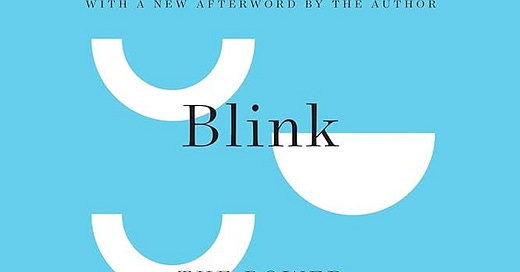Why You Should Read Blink: The Power of Thinking Without Thinking
Malcolm Gladwell’s book about how to train our subconscious to think for us offers a lot about how our minds can use little information to make more rapid and precise judgements
We are often confronted with making decisions rapidly: choosing whether to swerve or brake when a car suddenly cuts in front of us, deciding whether to catch a falling object or let it drop, or determining whether a noise in the dark is harmless or threatening. In retrospect, we may of course regret some of the decisions we make. In Blink: The Power of Thinking Without Thinking, Malcolm Gladwell cautions against this overthinking and analysis of every detail. Particularly, the book explores the concept of thin-slicing — how we can train our minds to trust our intuitive decision-making to help us arrive at accurate conclusions in the blink of an eye.
Gladwell employs a variety of techniques like varying syntax and style to make his point. While immersed in modern culture, he knows the Bible by hand and a lot of history — a breadth that not a lot of authors use in their writing. He presents real-life examples like the decision-making of people with intense jobs, such as firefighters and military strategists, to demonstrate the remarkable ability of the human mind to make snap judgements. He argues that sometimes, less information can lead to better decisions.
A quote from the book that supports this notion is:
“The key to good decision-making is not knowledge. It is understanding. We are swimming in the former. We are desperately lacking in the latter.”
Now you may ask, why should I care about this? In a fast-paced world, learning to understand the subconscious processes that influence our decisions, rather than solely relying on conscious knowledge, can help us keep up.
Of course, this method of letting your subconscious “think” for you isn’t perfect. After all, rapid, intuitive decision-making may overlook the importance of careful analysis and deliberation in certain contexts. Some critics argue that thin-slicing, for instance, can lead to errors, particularly in complex situations where careful consideration is necessary — for instance, surgery.
Most of the time, though, a lot of the information we read does not all have to be meticulously studied to be understood. Say you need to read a long passage in a very short amount of time. I guarantee you that you will not need more than the introduction and conclusion paragraphs, as well as the introductory and concluding sentences of each body paragraph, to make an accurate judgement about what the passage is generally about. This is where you can use thin-slicing to your advantage because the point is to just focus on what’s important.
Now, I want to end with a short story about an experience where I used the lessons taught in Blink to my advantage.
A couple years ago, during an interview for a position at an online science publication, the editor-in-chief unexpectedly asked me to pitch a feature article on quantum physics, a subject far removed from my background in biology. At first, I thought to myself “What? How do I formulate an answer without embarrassing myself for my incredible lack of knowledge of quantum physics??”. Until I remembered the lesson in Chapter 2: a little bit of knowledge can go a long way. Using my limited knowledge in quantum physics, I crafted a narrative on how quantum mechanics could offer insights into the unpredictable chemical dynamics of cellular processes like protein folding (which I am much more familiar with) and discussed with the interviewer why it would be an innovative idea for a research article for the publication. The interviewer hilariously ended the interview there, saying “There’s no need for more questions, we would love to have your write for our publication.”
Without reading Blink, I don’t know if I would’ve gotten the position.






